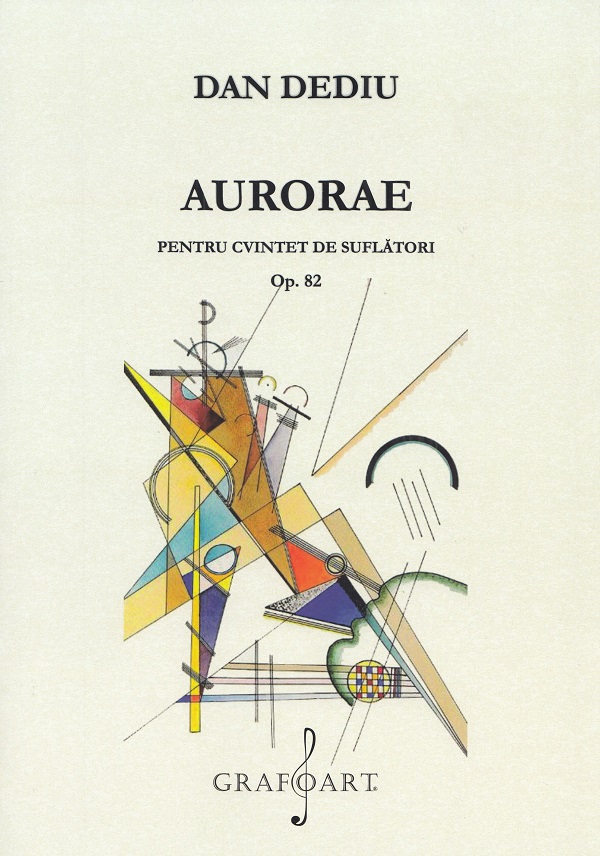Aurorae pentru cvintet de suflători Op. 82
Aurorae for woodwind quintet was written in 1999 and dedicated to the Zurich Wind Quintet. The poetic idea of the piece could be seen as a new extension of a poetic field that is imprinted by Schumann's piano work as a paradigm, the "Gesange in der Fruhe" Opus 133. Aurorae is a sonorous condensation of a border, a transition between night and day. The mystery of this phenomenon has been translated into various sound worlds. These soundscapes suggest a variety of techniques and compositional ideas: a pastoral-visceral, joyful beginning (Fanfare), a nervously figured chorale (Flammes), hymnlike heterophonies (Abeilles et Te lucis), mystical-bucolic melodies (Pieta), scherzoesque and macabre gestures (Dance of the Dead). The five pieces were conceived as small concerts for one instrument each. So each soloist brings a colour of dawn through his sound and instrumental technique. First the horn and then, in the row, flute, clarinet, oboe and bassoon show different angles and affects of their sound.
Now about the sound-worlds: in Fanfara there are two worlds: a visceral primeval world conceived as a Dionisian dance and a pastoral world, calmer but still threatening enough (the horn). Flammes develops a chorale melody and harmony as a stable ground, as a natural appearance, and in addition brings a lively and spiritual restlessness, mainly in flute. A hymnal ethos is found in Abeilles et Te lucis: a Byzantine melody as the framework of a cluster and modal technique and a Gregorian chant (Te lucis ante terminum) produced by clarinet timbre and aksak rhythm alternate like two Janus-headed facets. The daybreak as dawn full of sacred experiences is revealed by Pieta: a ray of sunlight wakes up the Mother of God, microtones on oboe support the incantatory impression. Totentanz could be defined as a negative hymn. Here we hear the dawn of the infernal: macabre gestures and infernal contexts chromaticize a diatonic light melody.
Descrierea produsului
Aurorae for woodwind quintet was written in 1999 and dedicated to the Zurich Wind Quintet. The poetic idea of the piece could be seen as a new extension of a poetic field that is imprinted by Schumann's piano work as a paradigm, the "Gesange in der Fruhe" Opus 133. Aurorae is a sonorous condensation of a border, a transition between night and day. The mystery of this phenomenon has been translated into various sound worlds. These soundscapes suggest a variety of techniques and compositional ideas: a pastoral-visceral, joyful beginning (Fanfare), a nervously figured chorale (Flammes), hymnlike heterophonies (Abeilles et Te lucis), mystical-bucolic melodies (Pieta), scherzoesque and macabre gestures (Dance of the Dead). The five pieces were conceived as small concerts for one instrument each. So each soloist brings a colour of dawn through his sound and instrumental technique. First the horn and then, in the row, flute, clarinet, oboe and bassoon show different angles and affects of their sound.
Now about the sound-worlds: in Fanfara there are two worlds: a visceral primeval world conceived as a Dionisian dance and a pastoral world, calmer but still threatening enough (the horn). Flammes develops a chorale melody and harmony as a stable ground, as a natural appearance, and in addition brings a lively and spiritual restlessness, mainly in flute. A hymnal ethos is found in Abeilles et Te lucis: a Byzantine melody as the framework of a cluster and modal technique and a Gregorian chant (Te lucis ante terminum) produced by clarinet timbre and aksak rhythm alternate like two Janus-headed facets. The daybreak as dawn full of sacred experiences is revealed by Pieta: a ray of sunlight wakes up the Mother of God, microtones on oboe support the incantatory impression. Totentanz could be defined as a negative hymn. Here we hear the dawn of the infernal: macabre gestures and infernal contexts chromaticize a diatonic light melody.
Detaliile produsului













